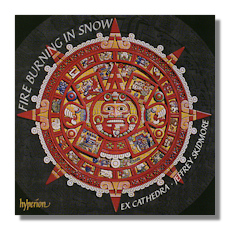
The Internet's Premier Classical Music Source
Related Links
- Araujo Reviews
- Latest Reviews
- More Reviews
-
By Composer
-
Collections
DVD & Blu-ray
Books
Concert Reviews
Articles/Interviews
Software
Audio
Search Amazon
Recommended Links
Site News
 CD Review
CD Review
Juan de Araujo

Fire Burning in Snow
Baroque Music from Latin America III
- Dixit Dominus
- Silencio, pasito
- Dime, amor
- ¡A, de la región de Luces!
- ¡A, del cielo!
- ¡Fuego de amor!
- En el muy gran Padre Ignacio
- Dios de amor
- ¡A, del tiempo!
- Salazar, ¡Salga el torillo hosquillo!
- Anonymous, Seventeenth Century, Ritual formulario: Hanacpachap
Ex Cathedra Consort & Baroque Ensemble/Jeffrey Skidmore
Hyperion CDA67600
Also available on Hyperion SACD67600: Amazon - UK - Germany - Canada - France - Japan - ArkivMusic - CD Universe
The title of this CD, the third in the series "Baroque Music from Latin America", is intended to convey the florid passions and contrasts of a continent and its music at a particular time:
La nieve y el fuego canten
sus glorias a emulación
que arder en la nieve el fuego de amor los efectos son.
…fire burning in snow is the effect of love. Something to bear in mind when thinking of the American Baroque. Derivative in some respects it may be (listen to the "Dixit Dominus", [tr.2], for example; or ¡A, De La Región De Luces! [tr.5] – very redolent of Monteverdi). But the music presented on this imaginative and nicely-produced CD from Hyperion is lively, moving, varied and… exciting.
At the center of this collection is the music of Juan de Araujo. Born in Spain in 1648, he emigrated to South America when young and lived, variously, in what are now Panama, Peru and the Bolivian judicial capital, Sucre, where he was organist at the cathedral for the last 30 years of his life, to 1712. In his colorful essay accompanying this CD, director of Ex Cathedra Jeffrey Skidmore describes how the atmosphere of this small once rich city at 3,000 meters still affected him in researching what remains a minority musical interest. The writing of de Araujo is not so consistently profound, eloquent nor comfortingly solid as that of Monteverdi – nor indeed that of Lully, Buxtehude, Biber or Corelli, with whom he is roughly contemporary. It lacks their range and depth, their sense of being able to turn around and review the music, painting and drama of contemporaries in Europe.
One wonders whether, perhaps, Skidmore takes the pace of pieces like En el muy gran Padre Ignacio [tr. 9] a little too fast to let them breathe. And consequently gives the impression that de Araujo was some how cut off from musical developments in Europe at the time and thus either felt forced to emulate and condense what was mainstream in Europe – his connections with "home" must have been slim. Or was he just naturally more inward-looking and less adventurous than, say, Biber or Purcell. On the other hand the largest part of the music here is engaging, full of life and driven – by a religious fervor that clearly sustained those early pilgrims, as well as the more familiar ones hundreds of miles to the north. (Not all the music is sacred: ¡Salga el torillo hosquillo! [tr.11] by Salazar (c. 1660-1709) is a rollicking bullfighting song.)
Yet there is more to this music than a reproduction of what de Araujo would have known had he stayed in Spain. He seems as comfortable when writing more generally compassionate music than the strict life of his cathedral demanded (and in which he was evidently at home). For instance there are apparent invocations to address rivalry between gangs and to welcome into local communities the African slaves who survived the mines; there are evocations – and invitations – to dance. It's to be hoped that these pieces, which are not on this CD, Ex Cathedra will record for future volumes.
As it is, nine of the eleven pieces here (the Hanacpachap is split into four segments, recurring throughout the recording) are receiving what Skidmore believes to be their first recording. That's reason enough to get and enjoy this CD. The music is played freshly, with a good balance of outward and introspective energy and in such a way that its melodic and instrumental strengths emerge clearly and with impact. No intrusive effects; nothing to try and enhance what really doesn't need enhancing. Percussion (usually added speculatively) is discreet and sparing.
There is curiosity value in this music: the influence of dance, the forces for which these pieces were conceived (¡Fuego de amor!, [tr. 8], for example, was written for four choirs). What we can tell of the expertise expected of contemporary performers also intrigues. But think beyond these issues and there is here a good hour and a quarter of music, Yes that sparkles; but that also pays repeated listening for its melodiousness, uninhibited joie de vivre and good humor. As hinted at, a slightly more relaxed realization by Ex Cathedra and Skidmore might have worked just as well. But no points lost for this. Particularly since the balance between soloists and ensemble singing here, the instrumental togetherness and clarity of the performers and the persuasive approaches to the relationships between words and music are all highly effective. The acoustic is crisp and translucent. The booklet contains the texts in Spanish and English. On the whole a CD actively to consider.
Copyright © 2009, Mark Sealey




















